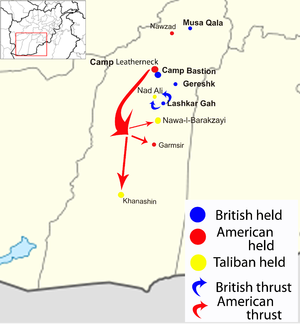Operation Strike of the Sword
| Operation Strike of the Sword (Khanjar) | |||||||
|---|---|---|---|---|---|---|---|
| Part of the War in Afghanistan (2001–14) | |||||||
 Operation Strike of the Sword in red; Operation Panther's Claw in blue |
|||||||
|
|||||||
| Belligerents | |||||||
|
|
|
||||||
| Commanders and leaders | |||||||
|
|
|
||||||
| Strength | |||||||
| 4,000 (USMC) 650 (ANA) |
Unknown | ||||||
| Casualties and losses | |||||||
|
ANA: 2 killed Interpreters: 1 killed |
at least 49–62 killed | ||||||
Operation Strike of the Sword or Operation Khanjar was a US-led offensive in Helmand province in southern Afghanistan. About 4,000 Marines from the 2nd Marine Expeditionary Brigade as well as 650 Afghan troops were involved, supported by NATO planes. The operation began when units moved into the Helmand River valley in the early hours of July 2, 2009. This operation was the largest Marine offensive since the Battle of Fallujah in 2004. The operation was also the biggest offensive airlift by the Marines since the Vietnam War.
The Marines pushed into primarily three significant towns along a 75-mile stretch of the Helmand River valley south of Lashkar Gah. At least two Marine infantry battalions and one Marine Light Armored Reconnaissance (LAR) battalion spearheaded the operation. In the north, 2nd Battalion, 8th Marines (2/8) pushed into Garmsir district. In central Helmand, 1st Battalion, 5th Marines (1/5) pushed into Nawa-I-Barakzayi to the south of Lashkar Gah, 2nd Light Armored Reconnaissance Battalion (2nd LAR) entered Khanashin in the Khan Neshin district.
Since 2001, Helmand province was considered to be a Taliban stronghold and had been one of the most dangerous provinces for coalition forces in Afghanistan, with British troops being locked in a stalemate since 2006. The large expanse of land made controlling the province difficult, while volunteers from across the Muslim world and hundreds of local Afghan nationals continued to join the insurgency. There was a growing concern among U.S. military and intelligence officials that much of the violence that has plagued Helmand was linked to a flow of fighters and munitions particularly from Pakistan's Balochistan region.
...
Wikipedia
